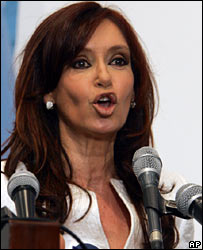As someone concerned with women’s issues, I thought it might be a good idea to step back from narrow policy discussions and consider women in Latin America more broadly. What follows is an anecdotal survey of women’s issues and an assessment of obstacles women in several Latin American contexts, like women everywhere, still face in their quest for equality and advancement.
Cristina: Throughout Latin America, the office of the presidency has been an exclusive boys Cristina Fernandez de Kirchnerclub during much of the region’s republican history. Long the chokehold of caudillos, machismo, and innumerable glass ceilings, Latin America currently has more women serving as president of their countries than any other region in the world. As Cristina Fernandez de Kirchner took control of Argentina in December, joining Michelle Bachelet of Chile on the world stage, it seems that the ceiling has finally been broken and Latin American women, at least in the traditional political arena, are equal to their male peers. (A separate question, of course, is how much the women presidents are being evaluated on their own merits – Cristina Fernandez de Kirchner succeeds her husband in the presidency and has been battling comparisons to that other famous Argentine woman president, Evita.)
The Church: In Nicaragua, on the other hand, women’s issues appear to be moving backward. Nine of the country’s most prominent female civil society leaders have been criminally charged for their activities in defense of women’s fundamental human rights. The accusations against this group of women, which includes a psychologist and several members of the Red de Mujeres Contra La Violencia, a leading NGO, were filed by the “Pro Human Rights National Association” (ANPDH), an organization sponsored by right-wing catholics and the secretary of the Nicaraguan Episcopal Conference. The charges have to do with a controversial case in which a 9-year-old girl was raped and became pregnant and received a therapeutic abortion to save her life. In other words, this seems to be an attempt to discredit these women and their organizations more than it is a serious criminal matter. Moreover, and along similar lines, the Nicaraguan national legislature in 2006 – in the height of a presidential election campaign and under considerable pressure from conservative forces in the country, including the Church – passed an absolute ban on abortion, disallowing life-saving procedures long considered medical necessities. The negative effects of this ban are extensive and well-documented – as many as 82 women have died because they have had complications to their pregnancies that a therapeutic abortion would’ve relieved. Human Rights Watch documented the deterioration of women’s reproductive rights in Nicaragua in an October 2007 report titled “Over Their Dead Bodies” and the Inter-American Commission on Human Rights has taken up several cases.
Ciudad Juárez: And in Ciudad Juárez, Mexico, women are still disappearing at an alarming rate. For over ten years now, the bodies of young women turn up with gruesome regularity in the desert that surrounds the city, and many more have vanished without a trace. Several theories exist as to why so many women disappear and who is behind these disappearances. One holds that young women who work in Juarez’s many factories are held captive by their need for public transportation and thus vulnerable to attack. One journalist has put forth the theory that a ring of Mexican government officials and prominent Juárez citizens “disappear” the women for sport. To date, justice has largely gone unserved in Juárez.
Women human rights activists who bravely speak out about these atrocious crimes face Lydia Cachothreats to their lives as well. Lydia Cacho, a prominent Mexican journalist who has exposed child trafficking rings in Cancun and has investigated the unsolved murders in Juárez, faces regular threats against her life, possibly even from within the Mexican government. Women activists are targeted for gender-based harassment and even violence that their male counterparts do not have to face, even when not working on behalf of women’s rights. Digna Ochoa, a human rights lawyer in Mexico City, was raped and murdered in 2001. Women trade unionists in Colombia, to cite another example, face similar gender-specific risks.
On balance, then, where do women’s issues in Latin America stand? It seems that for every one step forward (and one should not underestimate the importance of two women elected president as a positive step), the hemisphere takes two steps back. But is that a phenomenon unique to Latin America? I would be hard pressed to make that argument. Latin American women, like women everywhere, still face significant uphill battles, and the few anecdotal bits of evidence I have chosen to include in this post do not bring to light the vast majority of them.

Reply